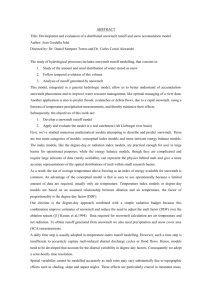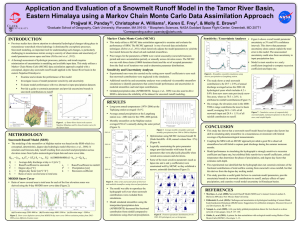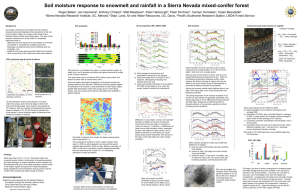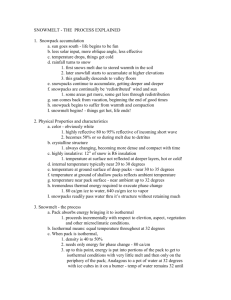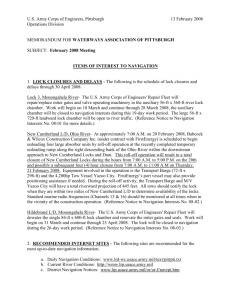By Paloma D'Silva, GEOG 4400F Snowmelt Modelling and
advertisement
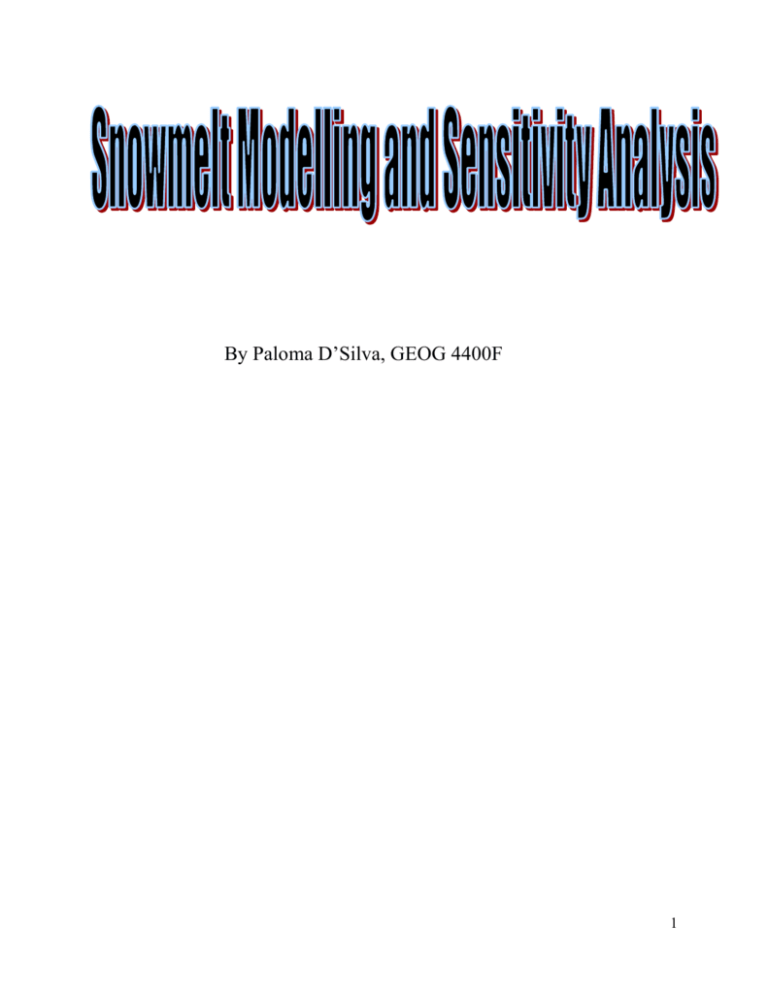
By Paloma D’Silva, GEOG 4400F 1 EXERCISE #1-SNOWMELT MODELLING AND SENSITIVITY ANALYSIS By Paloma D’Silva Introduction The purpose of this lab is to calculate snowmelt for a wet meadow site, Polar Bear Pass, in both 2008 and 2009. This was done using the energy balance equation, Qm = Q* + Qh + QE + QG + QP-Qcc, where Qm is snowmelt/heat available for melt in MJ/m2, Q* is net radiation in (W/m2), Qh is sensible heat in (W/m2) QE is latent heat in (W/m2), Qg is ground heat flux, which was assumed to be zero in this lab due to isothermal conditions, Qp (W/m2) is heat advected on by rain or snow, and Qcc is cold content in W/m2. The details of the calculations are given on the Excel spreadsheet. After snowmelt calculations were computed, we compared them with measured values for surface snow ablation measurements and to determine the reliability of our approach. Negative values for snowmelt are snowmelt gains, and positive values are losses. The larger a negative a value is, the more the gain of meltwater output, and vice versa. Figure 1 shows the simulated snowmelt versus the measured snowmelt for Polar Bear Pass in 2008 in form of an XY scatter graph, and Figure 2 shows it in a cumulative time-plot. Figure 1-XY Scatter Graph, 2008 Simulated vs Measured Snowmelt, 2008 Snowmelt(mm) 15.00 Simulated Snowmelt(mm) 0.28 -0.10 -2.03 1.02 2.34 2.62 R² = 0.5968 10.00 R² = 0.0472 5.00 0.00 155 -5.00 160 165 170 Measured Snowmelt(mm) - 0.7 4.1 5.4 12.5 - Julian Day Figure 2-Cumulative Time Plot, 2008 Cumulative Time Plot Snowmelt(mm) 80.00 60.00 40.00 R² = 0.5608 R² = 0.7777 20.00 0.00 -20.00 150 155 160 165 170 Simulated Snowmelt(mm) -0.28 Measured Snowmelt(mm) - JDAY 2 In comparing the graphs above, the cumulative time-plot for 2008 shows that the simulated snowmelt more or less follows the same trend as the measured snowmelt. However, measured snowmelt has a lot more variations, and tends to zigzag, whereas simulated snowmelt increases more smoothly. The cumulative time-plot shows the increase in snowmelt with time. The next two graphs show the calculated versus measured snowmelt for Polar Bear Pass in 2009. Once again, the units are the same as for Polar Bear Pass in 2008, and the same calculations were performed. The values for 2009, however, are different from those for 2008. Figure 3 is a scatter graph, whereas Figure 4 is a cumulative time-plot. For 2009, there were several anomalies in the scatter graph for the measured snowmelt, but the simulated snowmelt did not have many anomalies. A reason for this could be that simulated snowmelt was theoretical snowmelt. For the cumulative snowmelt in year 2009, there was more variation in measured snowmelt than simulated snowmelt. A possible explanation for this is that measured snowmelt represents the actual values that were measured, and there is bound to be variation in these values because of surface conditions, whereas theoretical snowmelt is under theoretical conditions. Out of the two approaches of cumulative time plot versus scatter graph, the cumulative time plot is more accurate because it has a better fit, and it accounts for change over time, which is an important factor to consider when calculating snowmelt. The correlation coefficient, R is found by taking the square root of R^2 which is displayed on each graph, and the closer it is to 1, the more accurate the fit. Figure 3—XY Scatter Graph, 2009 Polar Bear Pass, 2009 Snowmelt(mm) 20 Simulated Snowmelt(mm) 15 10 R² = 0.3362 5 R² = 0.4833 0 -5 140 -10 150 160 170 Measured Surface Ablation(mm) JDAY Figure 2 Cumulative Time Plot Snowmelt(mm) 60 Simulated Snowmelt(mm) 40 R² = 0.6086 20 0 -20 140 R² = 0.4833 150 160 JDAY 170 Measured Surface Ablation(mm) 3 Sensitivity Analysis A sensitivity analysis is a technique used to determine how different values of an independent variable will impact a particular dependent variable under a given set of assumptions 1. Sensitivity analyses were performed on both 2008 and 2009 data. In order to perform the sensitivity analysis, Table 1 below was used. Each variable below was altered subsequently, and only one variable at a time was changed to calculate its influence on snowmelt output (mm). For example, Q*, the net longwave radiation in W/m^2 was first changed to 0 for both years. Tables 2 and 3 show simulated (computed) snowmelt before sensitivity analyses were performed, for years 2008 and 2009 at Polar Bear Pass. Table 1-Suggested Meteorological and Terrestrial Conditions Q* Ta zo U snow depth (mm) +/-0.0 +/-0.0 +/-0.0 +/-0.0 +/-0.0 +/-10% +/-10% +/-10% +/-10% +/-10% +/-25% +/-25% +/-25% +/-25% +/-25% Table 2-Polar Bear Pass, 2008 JDAY Simulated Snowmelt(mm) 154 155 156 157 158 159 160 161 162 163 164 165 166 167 168 -0.28 -0.10 -2.03 -1.02 2.34 2.62 -1.25 -1.28 -0.07 10.00 9.99 6.69 4.40 12.26 9.90 Table 3-Polar Bear Pass, 2009 JDAY Simulated Snowmelt(mm) 146 147 148 149 150 151 152 153 154 155 156 157 158 -2.48 -2.04 -2.62 -3.87 -3.54 -1.57 1.22 -1.22 -1.51 -4.43 -2.02 -1.41 0.75 “Calibration, verification, and sensitivity analysis of the. HEC-HMS hydrologic model.” Prepared by Cunderlik, JM and Simonovic, SP. Project Report IV, August 2004. www.eng.uwo.ca/research/iclr/fids/.../Report%20IV.pdf 1 4 159 160 161 162 0.4 0.97 1.56 1.87 Changing Q*(W/m^2) Table 4 below shows the change in Q* as compared with the initial values, for 2008. Table 5 shows the change in Q* as compared with the initial values in 2009. Table 4-Change in Q*, 2008 Snowmelt output under Q* at 0(mm) JDAY Simulated Snowmelt(mm) 154 155 156 157 158 159 160 161 162 163 164 165 166 167 168 -1.55 -1.36 -3.96 -2.89 -2.37 -3.13 -4.29 -4.58 -4.17 -1.13 -1.14 -2.06 -1.32 -0.96 -0.81 -0.28 -0.10 -2.03 -1.02 2.34 2.62 -1.25 -1.28 -0.07 10.00 9.99 6.69 4.40 12.26 9.90 Snowmelt output under Q* +/-10% (mm) -0.15 0.03 -1.84 -0.84 2.82 3.19 -0.95 -0.95 0.34 11.12 11.10 7.56 4.97 13.58 10.97 Snowmelt output under Q* +/25%(mm) 0.04 0.21 -1.55 -0.56 3.52 4.05 -0.49 -0.45 0.95 12.79 12.77 8.88 5.83 15.57 12.58 When Q* was changed to 0, snowmelt output increased in both 2008 and 2009, as shown on the table. When Q* was increased by 10%, snowmelt output slightly decreased. When Q* was increased by a factor of 25%, snowmelt output greatly decreased from its original value. This relationship shows that as Q* increases, snowmelt output decreases. A graph of this is shown below in Figure 3. Figure 3-Sensitivity Analysis for Q*, 2008 Sensitivity Analysis for Q*, 2008 20 Simulated Snowmelt(mm) Snowmelt(mm) 15 10 Snowmelt output under Q* at 0(mm) 5 0 150 155 160 -5 -10 JDAY 165 170 Snowmelt output under Q* +/-10% (mm) Snowmelt output under Q* +/25%(mm) 5 Table 5 shows a similar phenomenon. The values below show simulated snowmelt with the change in Q* for Polar Bear Pass, 2009. As with the 2008 data, when Q* was changed to 0, snowmelt output (mm) was more than simulated snowmelt on the same day. However, as compared to the 2008 data, the magnitude that snowmelt changed by was much less. The difference was not quite as large. When Q* was increased by a factor of 10%, snowmelt (mm) slightly decreased generally. When Q* was increased by a factor of 25%, snowmelt actually decreased slightly as compared with simulated snowmelt, which was true for year 2008 as well. A reason for the different magnitudes of change in both the years was that in 2009, the values were much closer together and did not change as much, so Q* was not as affected. This data is graphed in Figure 4. As observable from both of the graphs, changing Q* by 10% or 25% did not change the computed snowmelt significantly. Therefore, changing Q* has a marginal effect on the data. Table 5-Change in Q*, 2009 Snowmelt output under Q* at 0(mm) JDAY Simulated Snowmelt(mm) Snowmelt output under Q* +/-10% (mm) Snowmelt output under Q* +/25%(mm) 146 -2.48 -2.61 -2.47 -2.45 147 -2.04 -2.08 -2.04 -2.03 148 -2.62 -3.43 -2.54 -2.42 149 -3.87 -5.09 -3.75 -3.57 150 -3.54 -4.83 -3.41 -3.21 151 -1.57 -3.02 -1.42 -1.21 152 1.22 -2.57 1.6 2.17 153 -1.22 -3.32 -1.01 -0.69 154 -1.51 -2.82 -1.38 -1.19 155 -4.43 -4.18 -4.45 -4.49 156 -2.02 -2.74 -1.95 -1.84 157 -1.41 -1.72 -1.37 -1.33 158 0.75 -1.43 0.97 1.3 159 0.4 -1.59 0.6 0.9 160 0.97 -2.07 1.28 1.73 161 1.56 -1.78 1.89 2.39 -1.95 2.25 2.82 162 1.87 6 Figure 4-Q* Sensitivity Analysis, 2009 Sensitivity Analysis, Q*, 2009 4 3 Snowmelt(mm) 2 Simulated Snowmelt(mm) 1 0 -1 145 150 155 160 -2 165 Snowmelt output under Q* at 0(mm) Snowmelt output under Q* +/-10% (mm) -3 -4 Snowmelt output under Q* +/-25%(mm) -5 -6 JDAY Changing Ta(ᵒC) Ta is the temperature of air in degrees Celsius (ᵒC). When Ta was changed to 0, advected heat was 0 W/m^2. However, the simulated snowmelt when Ta was changed very marginally changed, and was quite close to the original value. This shows that Ta does not have a significant effect on simulated snowmelt (mm) conditions. When it was increased by a factor of 10% in 2008, simulated snowmelt output (mm) was quite close to the original simulated snowmelt, with a very marginal decrease. When Ta was increased by a factor of 25% in 2008, the snowmelt output decreased more than the original value. From performing the sensitivity analysis, it can be observed that increasing temperature has a very slight increase on simulated snowmelt. This is observable in Figure 5, where we notice that changing Ta does not have a significant impact on the simulated snowmelt (mm). Table 6 is graphed in Figure 5. Table 6-Change in Ta, 2008 JDAY 154 155 156 157 158 159 160 161 162 163 164 165 166 167 168 Simulated Snowmelt(mm) -0.28 -0.10 -2.03 -1.02 2.34 2.62 -1.25 -1.28 -0.07 10.00 9.99 6.69 4.40 12.26 9.90 Snowmelt output under Ta at 0(mm) 0.19 0.19 -2.02 -1.91 2.04 3.07 -0.21 -0.19 0.55 9.49 9.59 5.58 3.56 11.51 9.07 Snowmelt output under Ta +/-10% (mm) -0.32 -0.13 -2.03 -0.93 2.37 2.57 -1.36 -1.39 -0.13 10.06 10.03 6.80 4.49 12.34 9.98 Snowmelt output under Ta +/-25% (mm) -0.39 -0.17 -2.03 -0.80 2.41 2.50 -1.51 -1.55 -0.22 10.13 10.09 6.97 4.62 12.45 10.11 7 Figure 5-Ta Sensitivity analysis(ᵒC) 2008 Sensitivity Analysis, Ta, 2008 14 12 Snowmelt(mm) 10 Simulated Snowmelt(mm) 8 Snowmelt output under Ta at 0(mm) 6 4 Snowmelt output under Ta +/-10% (mm) 2 0 -2 -4 150 155 160 165 170 Snowmelt output under Ta +/-25% (mm) JDAY A similar sensitivity analysis was performed for the year 2009, in Polar Bear Pass. The results from the sensitivity analysis are summarized in Table 7. When Ta was set to 0, snowmelt output actually decreased significantly. This was a sharp contrast from year 2008, when setting Ta to 0 had little effect on the simulated snowmelt. However, snowmelt output decreased for both years when Ta was set to 0. When Ta was increased by a factor of 10%, snowmelt output (mm) was slightly more than the original simulated snowmelt. This was similar to year 2008, when increasing Ta slightly increased snowmelt output, although it was very similar to original simulated snowmelt (mm). When snowmelt output was increased by a factor of 25%, snowmelt output increased by a larger amount, but the change was not quite significant. This was the same phenomenon as for year 2008. The day to day change was quite marginal. From performing the sensitivity analysis with Ta for both years, it is shown that changing Ta has a very slight increase on simulated snowmelt. As Ta increases, simulated snowmelt increases, so there is a small direct positive relationship between these two variables. When Ta increased, there was a larger net gain in calculated snowmelt. The results from 2009 have been graphed in Figure 6. Table 7-Sensitivity Analysis, Ta (ᵒC), 2009 JDAY 146 147 148 149 150 151 152 153 154 155 156 157 158 159 160 Simulated Snowmelt(mm) -2.48 -2.04 -2.62 -3.87 -3.54 -1.57 1.22 -1.22 -1.51 -4.43 -2.02 -1.41 0.75 0.4 0.97 Snowmelt output under Ta at 0(mm) Snowmelt output under Ta +/-10% (mm) -1.74 -1.60 -1.83 -2.42 -1.89 -0.38 2.06 -0.46 -1.29 -3.24 -1.35 -1.42 0.74 0.38 0.85 -2.56 -2.09 -2.70 -4.02 -3.70 -1.69 1.14 -1.29 -1.53 -4.55 -2.08 -1.40 0.75 0.40 0.99 Snowmelt output under Ta +/25%(mm) -2.67 -2.15 -2.82 -4.24 -3.95 -1.87 1.01 -1.40 -1.57 -4.72 -2.18 -1.40 0.76 0.40 1.01 8 161 162 1.56 1.87 1.39 1.61 1.57 1.89 1.60 1.93 Figure 6 Ta Sensitivity Analysis, 2009 3 2 Simulated Snowmelt(mm) Snowmelt(mm) 1 0 -1 145 150 155 160 Snowmelt output under Ta at 0(mm) 165 -2 Snowmelt output under Ta +/-10% (mm) -3 -4 Snowmelt output under Ta +/-25%(mm) -5 -6 JDAY Changing z0 (m) When z0, the surface roughness in m, was changed to 0, the drag coefficient was an error message. Therefore, for both years, I was unable to calculate snowmelt output when z0 was changed to 0. When it was increased by a factor of 10% in 2008 and 2009, snowmelt output was only marginally altered because the drag coefficient for both years changed to 0.002 instead of 0.003. The snowmelt output then decreased, for both years. Since the initial z0 was 0.001 mm for both years, the effect on snowmelt output was the same because the drag coefficient was the same. Therefore, to avoid redundancy, this sensitivity analysis only shows year 2008 because z0 for both years was the exact same value, resulting in the exact same percentage changes and the same effect on simulated snowmelt (mm). When z0 was changed by a factor of 10%, the values on simulated snowmelt (mm) were exactly the same. A possible explanation for this is that a 10% increase on 0.001 mm was not significant enough to alter the drag coefficient. There was no change in the snowmelt output with a 10% increase in z0. However, when z0 was changed by an increase of 25%, there was a slight change. The drag coefficient for both years changed to 0.004. Due to this, total snowmelt output for both years generally increased slightly. The change in z0 was significant for both years because z0 was the same for both years. A graph of this is shown in Figure 7. Table 8, Sensitivity Analysis by Changing z0 (m) JDAY Simulated Snowmelt(mm) 154 155 156 157 158 159 160 161 162 163 164 165 -0.28 -0.10 -2.03 -1.02 2.34 2.62 -1.25 -1.28 -0.07 10.00 9.99 6.69 Snowmelt output under z0 changed +/- 10% (mm) -0.28 -0.10 -2.03 -1.02 2.34 2.62 -1.25 -1.28 -0.07 10.00 9.99 6.69 Snowmelt output under z0 changed +/- 25% (mm) -0.39 -0.20 -2.35 -1.27 2.15 2.37 -1.58 -1.63 -0.40 9.90 9.89 6.51 9 166 167 168 4.40 12.26 9.90 4.40 12.26 9.90 4.28 12.17 9.81 Figure 7 Sensitivity Analysis of z0 Snowmelt(mm) 15 Simulated Snowmelt(mm) 10 Snowmelt output under z0 changed +/10% (mm) 5 0 150 -5 155 160 165 170 Snowmelt output under z0 changed +/25% (mm) JDAY Changing U (m/s) When U, the wind speed in m/s was changed to 0, in 2008, snowmelt output greatly decreased. As shown in Table 9, when U (m/s) was set to 0, all the values were positive. When wind speed was set to 0, the net loss in snowmelt output (mm) was much larger than the original simulated snowmelt (mm). When wind speed was increased by a factor of 10% and then 25%, respectively, snowmelt output (mm) increased for the first few days until Julian Day 162, but then there was a net loss that decreased with increasing U (m/s). This was graphed in Figure 8. As the magnitude of U(m/s) was shown to increase, with the exception of wind speed at 0 m/s, the snowmelt output was shown to decrease. The reason for this is that wind speed is a prohibiting factor to snowmelt output, and the more wind speed there is, the less snowmelt output can be recorded. Table 9, Sensitivity Analysis of U (m/s) 2008 JDAY Simulated Snowmelt(mm) 154 155 156 157 158 159 160 161 162 163 164 165 166 167 168 -0.28 -0.10 -2.03 -1.02 2.34 2.62 -1.25 -1.28 -0.07 10.00 9.99 6.69 4.40 12.26 9.90 Snowmelt output under U(m/s) at 0(mm) 1.09 1.16 1.91 2.00 4.76 5.66 2.86 3.13 4.03 11.29 11.26 8.94 5.92 13.43 10.95 Snowmelt output under U changed +/10% (mm) -0.41 -0.23 -2.42 -1.32 2.10 2.31 -1.66 -1.72 -0.48 9.87 9.86 6.47 4.25 12.15 9.79 Snowmelt output under U changed +/25% (mm) -0.62 -0.42 -3.01 -1.78 1.74 1.85 -2.28 -2.38 -1.10 9.68 9.67 6.13 4.02 11.97 9.64 10 Figure 8 Snowmelt(mm) Sensitivity Analysis of U(m/s) 16 14 12 10 8 6 4 2 0 -2 150 -4 Simulated Snowmelt(mm) Snowmelt output under U(m/s) at 0(mm) Snowmelt output under U changed +/10% (mm) 155 160 165 170 JDAY Snowmelt output under U changed +/25% (mm) A similar analysis was done for 2009 data, shown in Table 10. It is graphed in Figure 9. As observable from the graph, increasing wind speed (m/s) decreases snowmelt output. This is consistent with 2008 data, and the same phenomenon was observed in Figure 8. Table 10, Sensitivity Analysis of U (m/s) 2009 JDAY Simulated Snowmelt(mm) 146 147 148 149 150 151 152 153 154 155 156 157 158 159 160 161 162 -2.48 -2.04 -2.62 -3.87 -3.54 -1.57 1.22 -1.22 -1.51 -4.43 -2.02 -1.41 0.75 0.4 0.97 1.56 1.87 Snowmelt output under U(m/s) at 0(mm) -0.02 -0.07 0.67 1.07 1.10 1.24 3.62 1.99 1.27 -0.41 0.59 0.30 2.15 2.00 3.05 3.35 3.86 Snowmelt output under U changed +/10% (mm) Snowmelt output under U changed +/25% (mm) -2.73 -2.24 -2.95 -4.37 -3.99 -1.85 0.98 -1.54 -1.79 -4.83 -2.28 -1.58 0.61 0.24 0.76 1.38 1.67 -3.10 -2.54 -3.45 -5.12 -4.69 -2.27 0.62 -2.02 -2.20 -5.43 -2.67 -1.83 0.40 0.00 0.46 1.11 1.37 11 Figure 9 Sensitivity Analysis of Wind Speed, 2009 Simulated Snowmelt(mm) 6 Snowmelt(mm) 4 Snowmelt output under U(m/s) at 0(mm) 2 0 -2 145 150 155 160 165 Snowmelt output under U changed +/- 10% (mm) -4 -6 Snowmelt output under U changed +/- 25% (mm) JDAY Changing Snow Depth (mm) When snow depth (mm) was changed to 0, advected heat was changed to 0, and snowmelt output slightly decreased. There was a smaller net loss, as well as a smaller net gain in snowmelt. When it was increased by 10%, snowmelt output was the same as simulated snowmelt, with a difference of 0.01 mm. A reason for this could be that increasing 242 mm by 10% did not really make a difference in advected heat, since the change was quite small. When it was increased by 25%, advected heat increased, and snowmelt output slightly increased from days 154-156, then decreased. The net gains increased, as did the net losses, but very slightly. This table shows that snow depth only marginally influences meltwater output. Table 11 was graphed in Figure 10. Table 11- Sensitivity Analysis of Snow Depth (mm), 2008 Snowmelt output under snow depth(mm) at 0(mm) JDAY Simulated Snowmelt(mm) 154 155 156 157 158 159 160 161 162 163 164 165 166 167 168 -0.28 -0.10 -2.03 -1.02 2.34 2.62 -1.25 -1.28 -0.07 10.00 9.99 6.69 4.40 12.26 9.90 -0.10 0 -2.01 -1.15 2.30 2.70 -1.07 -1.10 -0.01 9.85 9.87 6.50 4.20 12.05 9.65 Snowmelt output under snow depth(mm) changed +10%(mm) -0.29 -0.11 -2.03 -1.01 2.35 2.61 -1.27 -1.30 -0.08 10.02 10.00 6.71 4.42 12.28 9.92 Snowmelt output under snow depth(mm) changed +25%(mm) -0.32 -0.13 -2.03 -0.99 2.35 2.59 -1.30 -1.32 -0.09 10.04 10.02 6.74 4.45 12.32 9.96 12 Figure 10 Sensitivity Analysis of Snow Depth, 2008 Snowmelt(mm) 15 Simulated Snowmelt(mm) 10 Snowmelt output under snow depth(mm) at 0(mm) 5 0 150 155 -5 160 165 170 JDAY Snowmelt output under snow depth(mm) changed +10%(mm) A similar analysis was done in 2009, shown in Table 12. This data has been graphed in Figure 11. When snow depth was set to 0 in 2009, the net gains and losses were only marginal. Snowmelt output slightly decreased, but very slightly. When snow depth (mm) was increased by a factor of 10%, snowmelt output increased by 0.02 mm or did not change at all. This is similar to the 2008 data in which increasing snow depth by 10% did not alter snowmelt output significantly due to the low initial value of snowmelt output. When snow depth was increased by a factor of 25%, snowmelt output increased by 0.04 mm for the first four days, then slightly increased by a small amount, or stayed the same as simulated output. This was slightly different from the same sensitivity analysis for 2008 data, when a 25% increase in snow depth resulted in slightly differing values of snowmelt output for all snowmelt output values. Table 12- Sensitivity Analysis of Snow Depth (mm), 2009 Snowmelt output under snow depth(mm) at 0(mm) JDAY Simulated Snowmelt(mm) 146 147 148 149 150 151 152 153 154 155 156 157 158 159 160 161 162 -2.48 -2.04 -2.62 -3.87 -3.54 -1.57 1.22 -1.22 -1.51 -4.43 -2.02 -1.41 0.75 0.4 0.97 1.56 1.87 -2.34 -1.93 -2.49 -3.72 -3.34 -1.36 1.39 -1.10 -1.47 -4.27 -1.89 -1.40 0.78 0.40 0.96 1.54 1.83 Snowmelt output under snow depth(mm) changed +10%(mm) -2.50 -2.05 -2.64 -3.89 -3.56 -1.59 1.20 -1.23 -1.52 -4.44 -2.03 -1.41 0.75 0.4 0.97 1.56 1.87 Snowmelt output under snow depth(mm) changed +25%(mm) -2.52 -2.07 -2.66 -3.91 -3.59 -1.62 1.18 -1.24 -1.52 -4.47 -2.05 -1.41 0.75 0.40 0.98 1.56 1.88 13 Figure 11 Sensitivity Analysis of Snow Depth(mm), 2009 Simulated Snowmelt(mm) 3 2 Snowmelt output under snow depth(mm) at 0(mm) Snowmelt(mm) 1 0 -1 145 150 155 165 Snowmelt output under snow depth(mm) changed +10%(mm) -2 -3 -4 -5 160 JDAY Snowmelt output under snow depth(mm) changed +25%(mm) Conclusions As was found in the study, calculated snowmelt was found to be the same as measured snowmelt except for a few minor discrepancies when simulated snowmelt and measured snowmelt were compared. The best method for comparing measured snowmelt versus calculated snowmelt was the cumulative time plot, because it took into account the time change and snowmelt accumulation. It was found to be more accurate than the scatter graph, and had a stronger correlation coefficient as well. When the sensitivity analysis was performed, the variable that was found to most influence meltwater output (mm) was the wind speed. When wind speed was altered, the snowmelt changed significantly. Results for both years were quite similar. Wind speed had the largest effect on snowmelt output, whereas surface roughness and snow depth had virtually no effect on snowmelt output. The approach that we used to calculate snowmelt output was quite accurate, because our calculated values more or less matched the values that were measured. However, there were some discrepancies due to our values being a theoretical yield, and measured values might have some measurement error as well as other surface conditions that were not taken into account in the energy balance model. 14

